.
.
.
.
.
.

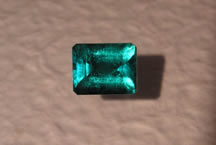 3.05 carat Emerald Cut. Please call 415 254 2474 for prices. I know it is old fashioned but I like to talk to the client before selling an emerald.
3.05 carat Emerald Cut. Please call 415 254 2474 for prices. I know it is old fashioned but I like to talk to the client before selling an emerald.
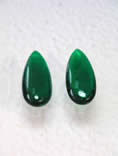 Pear Shape Cabochons, total weight 39.14 carats
Pear Shape Cabochons, total weight 39.14 carats
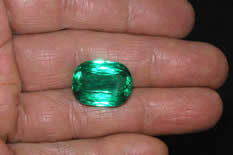 Oval 23.22 carat
Oval 23.22 carat
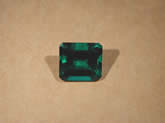 4.39 carat emerald cut
4.39 carat emerald cut
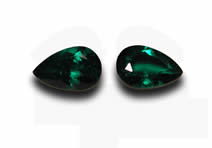 3.91 pair total weight. A second pair weighs 2.20 ct. These are fine stones as is evident in the image. Please call for prices.
3.91 pair total weight. A second pair weighs 2.20 ct. These are fine stones as is evident in the image. Please call for prices.
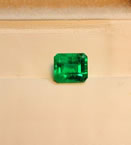 3.12 carats emerald cut; re-cut twice, now perfected.
3.12 carats emerald cut; re-cut twice, now perfected.
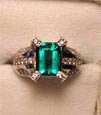 2.43 fine emerald in white gold.
2.43 fine emerald in white gold.
See more stones from our inventory
See Jewelry
Value in the Market
Increased sales of emeralds in 2007 were accurately predicted by viewing the jewelry store windows in Venice, Milan and Geneva the two previous years. There, evidence that Italian desginers were returning to the warm look of 18K gold with emeralds forecasted a trend in that direction. Consistent demand combined with an ever-devaluating dollar in Bogota, Colombia have produced price increases for Colombian emeralds of over 20% in two years. Just this year, 2007, has seen the value of the dollar drop 8%.
Five years from now it will be hugely evident that Colombian emeralds (and other colored stones) were undervalued - their rarity and beauty-per-dollar ratio will catch the attention of investors. Again, emeralds will gain in value with the other traditionals - ruby, sapphire and diamonds.
Another way to perceive value is that jewelers and dealers who buy from me come back again and again - proof that they are making profits re-selling my stones!
Emerald Quality; Colombian compared to Brazilian and African
You will often hear that Colombian emeralds are superior to African or Brazilian emeralds. In the same manner you will hear that rubies from Burma are superior to Thai rubies or rubies from other localities. It is really all about chemistry.
A gem material’s absorption and transmission of ight is influenced by the chemicals present in the stone. Emerald color comes from the presence of trace elements of chromium, vanadium and iron as impurities in the crystal structure of the stone. These impurities can be only one atom per million but they have a large effect on the visible color of the crystal. The presence or absence of each of these elements determine the color, tone and saturation of any emerald. The Colombian emerald is blessed with a chemistry of color that is near perfect: mainly chromium, a little of vanadium and very little or no iron. It is the chromium that gives the green color as well as the red fluorescence. Vanadium creates the green emerald color but without the red fluorescence. Iron atoms in the emerald will blunt the red fluorescence and also make the green less pleasing by adding yellowish or bluish where it is not needed.
The emerald from Colombia is considered to have the finest color. There is no discussion on this point; even when special pieces come from an Afghan or Brazilian mine, they compare the color to Colombian but never does anyone say, “This is better than Colombian color!” Read this quote from Emeralds of the World, by Julius Roger Sauer, Brazilian mine owner and exporter: “Muzo (Colombia) is the most famous of Colombia’s emerald mines. It has produced stones of matchless beauty for more than a thousand years. The rare, fine, saturated green crystals sometimes found there are the yardstick by which all other emeralds are judged.” But don’t take my (or Julius Sauer’s) word for it – spend time looking at as many emeralds as you can. You will begin to appreciate the rarity of perfect color in emeralds.
Refractive Index:
There are wide variations in emerald characteristics that depend on the origin of the stone. From country to country and even from mine to mine within the same country the refractive index and specific gravity will very slightly.
R.I. and S.G.
Colombian 1.57 (+ .006) & 1.577 (+ .007) 2.70 (+.02)
Uralian 1.579 (+ .002) & 1.585 (+ .002) 2.73 (+.02)
African + Indian 1.585 (+ .003) & 1.592 (+ .003) 2.74 (+.02)
Brazilian 1.570(+ .005) & 1.575 (+ .006) 2.69 (+.02)
Most Synthetics 1.561 (+ .003) & 1.564 (+ .003) 2.66 (+.02)
Birefringence
The measure of a crystal to transform a single ray of light into two rays of unequal velocity (and therefore, refractive index) is called birefringence. When the c-axis of the emerald crystal is placed parallel to the length of the refractometer's hemicylinder the reading of the R.I. is the highest. When placed perpendicular, it is the lowest. These two readings are given in the table along with the possible deviation depending on the crystal (in parenthesis).